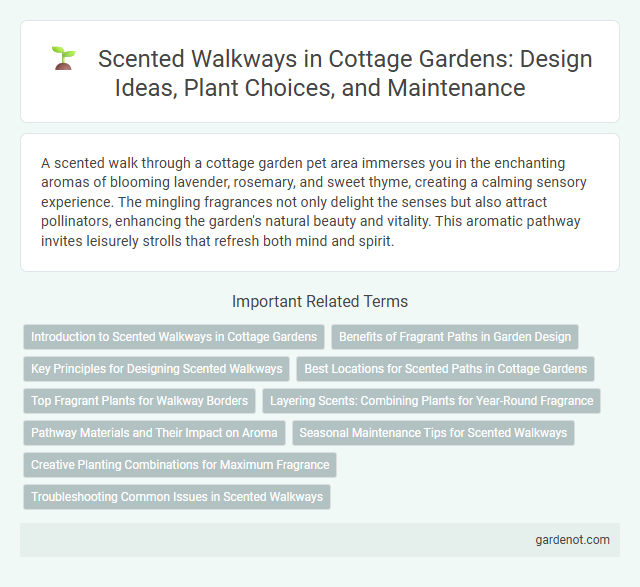A scented walk through a cottage garden pet area immerses you in the enchanting aromas of blooming lavender, rosemary, and sweet thyme, creating a calming sensory experience. The mingling fragrances not only delight the senses but also attract pollinators, enhancing the garden's natural beauty and vitality. This aromatic pathway invites leisurely strolls that refresh both mind and spirit.
Introduction to Scented Walkways in Cottage Gardens
Scented walkways in cottage gardens enhance outdoor spaces by combining fragrant plants like lavender, rosemary, and sweet alyssum along garden paths. These aromatic trails create an immersive sensory experience, inviting visitors to engage with the natural environment through delightful scents. Incorporating plants with varied blooming seasons ensures continuous fragrance throughout spring, summer, and autumn in the garden setting.
Benefits of Fragrant Paths in Garden Design
Fragrant paths in cottage garden design enhance sensory experiences by incorporating aromatic plants such as lavender, rosemary, and jasmine, which stimulate relaxation and reduce stress. These scented walks attract pollinators like bees and butterflies, promoting biodiversity and healthy garden ecosystems. Strategically placing fragrant shrubs and flowers along pathways also guides visitors naturally through the garden, creating an immersive and soothing environment.
Key Principles for Designing Scented Walkways
Crafting a scented walkway in a cottage garden hinges on selecting fragrant plants that bloom in succession, ensuring a continuous aromatic experience throughout the seasons. Incorporating herbs like lavender, rosemary, and thyme alongside flowering shrubs such as lilac and honeysuckle maximizes scent variety and intensity. Designing curved paths and varied planting heights enhances fragrance diffusion, inviting visitors to engage with the garden's sensory appeal.
Best Locations for Scented Paths in Cottage Gardens
Designing a scented walk in a cottage garden thrives in areas with ample sunlight and good air circulation, which enhances the release of fragrant blooms such as lavender, sweet peas, and rosemary. Ideal locations include pathways adjacent to seating areas, near entrances, or along garden fences where scent can linger and greet visitors. Positioning fragrant plants in raised beds or borders alongside winding paths maximizes sensory engagement and creates an immersive aromatic experience.
Top Fragrant Plants for Walkway Borders
Lavender, rosemary, and gardenia are top fragrant plants ideal for walkway borders in a cottage garden, offering a pleasant aroma that enhances the sensory experience. Sweet alyssum and lemon thyme contribute delicate, sweet scents that attract pollinators while creating a welcoming path. Planting these aromatic perennials along a garden path ensures continuous fragrance through multiple seasons, enriching the garden ambiance.
Layering Scents: Combining Plants for Year-Round Fragrance
Layering scents in a cottage garden involves combining fragrant plants such as lavender, rosemary, and sweet peas to create a seamless aromatic experience throughout the year. Incorporate early-blooming bulbs like hyacinths and late-season herbs such as thyme to maintain continuous fragrance. Strategic placement of scented shrubs like lilac and gardenia enhances the depth and variety of floral aromas along garden pathways.
Pathway Materials and Their Impact on Aroma
Pathway materials in a scented walk significantly influence the diffusion and intensity of garden aromas by retaining moisture and heat, which helps release essential oils from nearby plants. Natural materials such as crushed limestone, brick, or gravel offer porous surfaces that enhance scent dispersion by absorbing dew and warming under sunlight. Selecting path surfaces that complement scented plants like lavender, thyme, and rosemary ensures an immersive aromatic experience that evolves with changes in temperature and foot traffic.
Seasonal Maintenance Tips for Scented Walkways
Seasonal maintenance of scented walkways in a cottage garden involves regular pruning of fragrant plants like lavender, roses, and jasmine to promote healthy growth and enhance scent release. Mulching helps retain soil moisture and suppress weeds, ensuring continuous flower production throughout the growing season. Replenishing soil nutrients with organic compost in early spring supports vibrant blooms and sustained aromatic intensity.
Creative Planting Combinations for Maximum Fragrance
Creative planting combinations in a scented walk enhance sensory appeal by layering aromatic herbs like lavender, rosemary, and thyme with flowering plants such as jasmine, gardenia, and sweet peas. Incorporating evergreen shrubs like boxwood alongside fragrant perennials like heliotrope and dianthus ensures a continuous release of captivating scents throughout the growing season. Strategic placement of fragrant plants near pathways maximizes the olfactory experience, creating an immersive and soothing garden ambiance.
Troubleshooting Common Issues in Scented Walkways
Troubleshooting common issues in scented walkways involves addressing poor plant growth, pest infestations, and soil drainage problems that can diminish fragrance and visual appeal. Ensuring well-drained soil, selecting drought-tolerant aromatic plants like lavender and rosemary, and regularly inspecting for aphids or spider mites can maintain a thriving scented path. Mulching and proper pruning help sustain plant health and enhance the walkway's sensory experience throughout the seasons.
Scented walk Infographic

 gardenot.com
gardenot.com